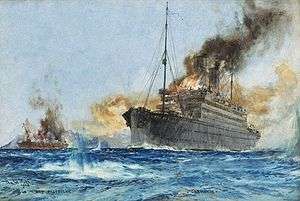RMS Carmania (1905)
 | |
| History | |
|---|---|
| Name: | RMS Carmania |
| Owner: | Cunard Line |
| Port of registry: | United Kingdom |
| Builder: | John Brown & Company, Clydebank |
| Yard number: | 366 [1] |
| Launched: | 21 February 1905 |
| Maiden voyage: | 2 December 1905 |
| Fate: | Scrapped in 1932 at Blyth, Northumberland |
| General characteristics | |
| Tonnage: | 19,524 grt |
| Length: | 650.4 ft (198.2 m) |
| Beam: | 72.2 ft (22.0 m) |
| Installed power: | Steam turbines |
| Propulsion: | three propellers |
| Speed: | 18 knots |
| Capacity: | 2,650, reduced to 1,440 in 1923 |
RMS Carmania was a British ocean liner designed by Leonard Peskett and built by John Brown & Company for the Cunard Line. In World War I, Carmania was converted to an armed merchant cruiser.[2]
History
When launched, Carmania and her running mate, Caronia, were the largest ships in the Cunard fleet.[3] Carmania had steam turbines and Caronia had quadruple-expansion engines.[4] Another feature that differentiated the two liners was that Carmania had two tall forward deck ventilator cowls while they were absent on Caronia. Carmania traveled the New York-Liverpool route from 1905 to 1910. In the spring of 1906, she carried H.G. Wells to North America for the first time; he noted in a book about his travels that "This Carmania isn't the largest ship nor the finest, nor is to be the last. Greater ships are to follow and greater."[5] Carmania suffered one major fire in June 1910. In October 1913, while eastward bound, she responded to a distress call from the Volturno to pick up survivors in a storm, resulting in many awards for gallantry being presented to various members of her crew and Captain James Clayton Barr.[6]
Following the outbreak of World War I, Carmania was converted into an armed merchant cruiser, equipped with eight 4.7 inch guns, and put under the command of Captain Noel Grant. She sailed from Liverpool to Shell Bay in Bermuda. She subsequently engaged and sank the German merchant cruiser SMS Cap Trafalgar, during the Battle of Trindade. At the time Cap Trafalgar's appearance had been altered to resemble Carmania.[7] The ship suffered extensive damage herself and several casualties to her crew. After repairs in Gibraltar, she patrolled the coast of Portugal and the Atlantic islands for the next two years. In 1916, she was summoned to assist in the Gallipoli campaign. From May 1916, she was used as a troop ship. After the war, she transported Canadian troops back from Europe.
By 1919, she returned to passenger liner service, being refitted in 1923. In 1932, she was sold to Hughes Bolckow & Co., and scrapped at Blyth.[8]
Gallery
 Capt. J. C. Barr in 1913
Capt. J. C. Barr in 1913- Engine room
 Battle of Trindade
Battle of Trindade
References
- ↑ "SS Carmania". Clydebuilt Ships Database.
- ↑ "S/S Carmania, Cunard Line". Norway Heritage.
- ↑ "Carmania (I)". The Great Ocean Liners.
- ↑ "Carmania". Chris' Cunard Page.
- ↑ H.G. Wells, The Future in America: A Search after Realities (New York and London: Harper and Brothers, 1906), pp. 21-24, 28-29, 32-35.
- ↑ "Capt. Barr Cites Log On Volturno. Says Carmania's Part in Rescue Work Was Misrepresented in English Reports.". New York Times. October 27, 1913. Retrieved 2010-02-26.
The Cunard liner Carmania arrived yesterday from Liverpool with forty-three survivors from the Volturno, including twenty-two women and children who had been rescued by the Leyland steamship Devonian and landed at Liverpool.
- ↑ Simpson, Colin (1977). The Ship that Hunted Itself. Penguin Books. ISBN 0-14-004823-5.
- ↑ "Carmania". World Naval Ships Directory. Retrieved 27 May 2013.